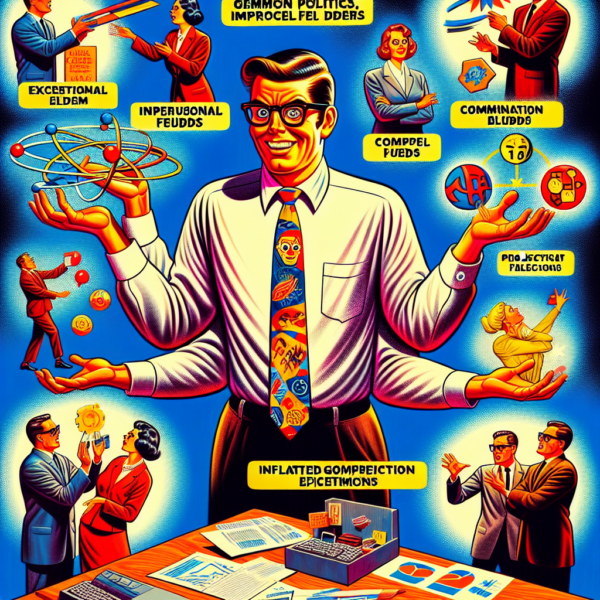Welcome to our discussion on “Dilbert and Project Management: A Humorous Take on Organizational Challenges.” For those unacquainted, Dilbert is a popular comic strip created by Scott Adams, which puts a witty, and often painfully accurate, lens on the corporate world and various professional scenarios. This satirical representation of office life, particularly the absurdities that are all too familiar in project management, has gained quite the cult following among professionals globally.
Remarkably, the connection between Dilbert and project management extends beyond mere comic relief. Often wrapped in a hearty laugh, we find nuggets of wisdom in Dilbert strips that expose the pitfalls and paradoxes often encountered in project management scenarios. These comics serve as a lighthearted commentary on the daily challenges faced by project managers and the dilemmas of organizational processes.
Therefore, it is only logical for us to explore this fascinating topic in detail. Throughout this blog post, we will dive into numerous Dilbert strips, unraveling the humor and insights they bring to the world of project management. We will be focusing on major problem areas like office politics, interpersonal conflicts within project teams, typical communication breakdowns, and the usual unrealistic expectations from stakeholders. Each of these areas will be explored through the enlightening and hilarious perspective that Dilbert provides.
Subsequently, we will dissect the representation of poor project management decisions and ineffective leadership examples that are a mainstay in Dilbert strips. Then, we will delve into the valuable lessons these humorous anecdotes provide and how they can inform our approach to smoother project management. By the end of this journey, you will hopefully not only have a good laugh but also gain some genuine insights that can be applied to real-world project management scenarios. Stay tuned for an enjoyable and enlightening journey into the world of Dilbert and project management.
Exploring Common Organizational Challenges through Dilbert
Over the years, Dilbert has provided a unique, often sardonic perspective on office politics. The comic strip creates a universally recognizable scene, revolving around power struggles, red tape, and divergent goals among functional divisions. Through the well-known characters’ interactions, readers gain a humorous yet enlightening perspective into the intricacies of office dynamics, exposing the absurdity and at times, the sheer futility of such politics.
When exploring interpersonal conflicts within a project team, Dilbert hits the nail on the head by illustrating the typical scenarios that precipitate disputes. By encapsulating issues like ego clashes, mismatched objectives, or just plain misunderstandings in humor, the comic strip successfully highlights the dysfunctions often rampant in project teams. The endearing yet ridiculous situations the characters find themselves in serve as a mirror reflecting the reactionary and often imprudent behavior exhibited during conflicts.
An essential aspect spotlighted through the Dilbert comic strip is the issue of communication breakdown within organizations. Whether it’s misunderstood emails, ignored memos, or cryptic manager-speak, Dilbert showcases how disarray in communication can disrupt the workflow and wreak havoc in project management. These scenarios are presented with humor but underscore the critical importance of effective communication channels in a project environment.
Lastly, Dilbert is famous for revealing the often-unrealistic expectations that stakeholders might have regarding project outcomes. From setting overambitious timelines to expecting cost structures that defy economic logic, these unrealistic expectations are exposed in a hilarious light, yet they hint at a serious underlying problem. This comic strip, through its satirical lens, underscores the need for realistic planning and the dangers of setting unachievable goals. The situations carry a dose of humor, but they also make us reflect on the role of effective stakeholder management in successful project execution.
Dilbert’s Humorous Depiction of Project Management Missteps
In the world of Dilbert, project mismanagement appears to be the norm rather than the exception. It’s not uncommon to see the characters dealing with poorly defined project boundaries, lack of clear direction, or other managerial missteps. These scenarios are adjusted just enough to incite laughter, but they are built on an all-too-real foundation that any project manager can relate to. Dilbert serves as a mirror to show us how absurd our professional lives can become without effective project management.
Yet, the humor we find in these situations goes beyond clever puns or physical comedy. It’s rooted in the absurdity of the situations, the ridiculousness of project failure, and the overarching bureaucracy that often surfaces in corporate environments. We laugh when Dilbert’s boss demands an impossible project be completed overnight, or when a simple task is hindered by red tape and bureaucratic roadblocks. These humorous scenarios offer a hyperbolic look at the potential outcomes when project management falters.
The portrayal of leadership, or rather, ineffective leadership, is another prevalent theme in the comic strip. The Pointy-Haired Boss, Dilbert’s clueless superior, is a significant representation of leadership gaps that can sabotage a project. He typically issues vague directives, disregards input from his team, and steals credit for other people’s work – attributes of a disastrous leader. His character provides a stark contrast to effective leadership, which involves clear communication, delegation, and taking responsibility for one’s decisions.
Moreover, it’s not just the Pointy-Haired Boss who contributes to this chaos. All characters in Dilbert, in their unique way, contribute to the problems. Some are unmotivated, others are fiercely competitive, and a few are blissfully naive. These characters remind us of coworkers we might have encountered at one time or another, and their humorous interactions underscore the human element in project management. They show us that even with the best strategies and most sophisticated tools, a project is only as good as its team. Through this humorous depiction, we are encouraged to reflect on our own experiences and possibly identify similar missteps we have failed to recognize earlier.
In essence, Scott Adams manages to capture numerous project missteps that we see in our professional lives within the comic world of Dilbert. By using exaggerated humor and satire, Adams provides both comic relief and a critical commentary about the existing status quo in project management.
Insights Drawn from Dilbert’s Critique of Project Management
“Dilbert” serves as an enlightening medium that emphasizes the importance of effective communication in project management scenarios. This is evident in various strips where a communication breakdown leads to project failure. For instance, when the Pointy-Haired Boss inadequately describes the project requirements, Dilbert and his teammates are left deciphering the actual project needs, resulting in wasted time and resources. Hence, Dilbert project management highlights the frustrating consequences of unclear communication, urging project leaders to invest time in clarifying project requirements to their teams.
Next, the comic strip underlines the necessity of proper project planning and execution. Dilbert’s character often faces situations where their projects derail due to poor planning, resulting in delayed deliverables and discontented stakeholders. One notable strip shows the team having to work overtime because of a last-minute project change, a common project management debacle that could have been avoided with meticulous planning. This communicates the need for well-defined project plans and consistent progress monitoring for successful project execution.
Furthermore, the comic strip also stresses the necessity of setting realistic goals. Dilbert is often seen battling impossible project timelines and deliverables. One striking strip illustrates Dilbert having to develop an overly complex system within an implausible timeframe. Such scenarios in Dilbert project management subtly criticize overly ambitious goal-setting and present a case for setting achievable targets that encourage team engagement and success.
Leadership is another aspect that the comic strip scrutinizes. Ineffective leadership can lead teams astray, and “Dilbert” brings this out often with its depictions of the clueless Pointy-Haired Boss. The boss’s lack of understanding of the team’s technical knowledge coupled with ill-judged decisions often leads to project chaos. This underscores the need for competent leadership in project management based on a complete understanding of project dynamics and technicalities.
Lastly, the comic series serves as a mirror reflecting common managerial missteps in a humorous but critical light for us to avoid. For instance, when the boss in the series is more focused on following bureaucratic procedures rather than fostering innovation, it leads to stifled creativity and poor project results. Such scenarios highlight the pitfalls of prioritizing rigidity over flexibility in a project, encouraging us to create environments conducive to creativity and innovation in project management.
Applying Dilbert’s Lessons in Real-world Project Management
The real value in these humorous Dilbert strips lies in their practical lessons that, if applied, can significantly improve actual project management experiences. Even though Scott Adams, the creator of the comic strip, presents them in an exaggerated and entertaining manner, they contain quite a few important truths that are highly relevant in our professional lives.
One crucial element to understand is the immense impact that avoiding the project management mistakes highlighted in these strips can have. For instance, effective communication, proper project planning and execution, realistic goal setting, efficient leadership, and apt handling of conflicts can significantly influence the success of our project management efforts. Cleverly, Adams uses humor as a tool not only to entertain but also to educate his audience about these factors.
Typically, a project’s success is determined by its timely completion within the allocated budget while also meeting the agreed-upon standards and specifications. However, the numerous drawn-out meetings, unrealistic expectations, and disregard for the actual workload, as illustrated in Dilbert, often stand as obstacles. By simply avoiding these, the probability of project success can be amplified significantly.
While it may not seem immediately evident, maintaining a sense of humor in the stressful environment that often accompanies project management can have several benefits. A lighthearted atmosphere can facilitate better communication, foster a positive team environment, and can even assist in conflict management. Moreover, it is an effective stress-reliever that can make challenging situations more manageable and projects more enjoyable.
In essence, the lessons derived from Dilbert’s hilarious takes on project management can be highly practical and extremely valuable when applied correctly. Not only do they provide a fun and engaging way to understand a typically intimidating subject like project management, but they also serve as a reminder that sometimes, it’s okay to laugh at our mistakes, learn from them, and continue moving forward.
Conclusion
In this blog post, we delve into the world of the infamous comic strip character, Dilbert, and explore project management lessons conveyed in a humorous light. Our journey begins with understanding common organizational challenges such as office politics, interpersonal conflicts, communication breakdowns, and unrealistic project expectations through the eccentric lens of Dilbert’s satire. We analyze scenarios detailing project management missteps, the humor in failure examples, and instances of ineffective leadership that Dilbert painstakingly captures. Moreover, we glean substantial insights into the value of effective communication, proper project planning and execution, realistic goal-setting, and conflict management, all crucial for successful project management.
Further, we discuss how these insights and lessons drawn from Dilbert are not only satirical but also practical and applicable to real-world project management. It’s quite remarkable how much one can learn from these seemingly absurd comic scenarios, and how avoiding the same mistakes can profoundly impact project management outcomes for the better. We also explore the unique benefits of embracing humor, encouraging project teams to diffuse stressful situations by stepping back and laughing at our own follies.
Humor is a powerful tool in the world of project management, offering us a unique perspective on dealing with some of the toughest challenges. The infamous Dilbert, with his satirical takes on the corporate scene, serves as a humorous mirror for us to analyze our own experiences objectively. Keep exploring, keep learning, and remember, it’s okay to laugh at our own mistakes. We encourage each reader to keep an open mind, embrace these lessons, and most importantly, apply them to their own project management experiences. We would love to hear your humorous takes or experiences in dealing with project management. Let’s use humor not just as a mechanism to cope, but as a binding element that brings our teams together in challenging times!



